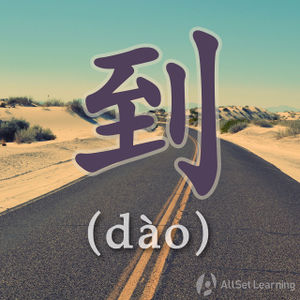Difference between revisions of "Expressing "until" with "dao""
| Line 1: | Line 1: | ||
{{Grammar Box}} | {{Grammar Box}} | ||
| − | One of the cool features of Chinese is complements, and in this article we introduce a few of them. | + | One of the cool features of Chinese is [[complements]], and in this article we introduce a few of them. |
== Structure == | == Structure == | ||
One kind of [[complement]] in Chinese involves putting 到, 给 or 在 after the verb. These are used to indicate direction, target and location, respectively. | One kind of [[complement]] in Chinese involves putting 到, 给 or 在 after the verb. These are used to indicate direction, target and location, respectively. | ||
| + | |||
| + | * 到 indicates that the action has obtained a goal or a certain state. Any verb that uses the complement [[Result complements "dao" and "jian"| 见]] can also use 到. | ||
| + | |||
| + | * 给 indicates that you have passed something from one person to another. | ||
| + | |||
| + | * 在 indicates a person or thing coming to a certain place. It is usually followed my a location or a place. | ||
<div class="jiegou"> | <div class="jiegou"> | ||
| Line 33: | Line 39: | ||
* [[New Practical Chinese Reader 2 (新实用汉语课本2)]] (pp. 240) [http://www.amazon.com/gp/product/7561911297/ref=as_li_ss_tl?ie=UTF8&tag=allset-20&linkCode=as2&camp=217145&creative=399369&creativeASIN=7561911297 →buy] | * [[New Practical Chinese Reader 2 (新实用汉语课本2)]] (pp. 240) [http://www.amazon.com/gp/product/7561911297/ref=as_li_ss_tl?ie=UTF8&tag=allset-20&linkCode=as2&camp=217145&creative=399369&creativeASIN=7561911297 →buy] | ||
| + | * [[Chinese Grammar Without Tears (简明汉语语法学习手册)]] (p.93-95) [http://www.amazon.cn/mn/detailApp/ref=as_li_ss_tl?_encoding=UTF8&tag=allset-23&linkCode=as2&asin=B0041UGAJU&camp=536&creative=3132&creativeASIN=B0041UGAJU →buy] | ||
[[Category:B1 grammar points]] | [[Category:B1 grammar points]] | ||
Revision as of 03:19, 14 March 2013
-
Level
-
Similar to
-
Used for
-
Keywords
One of the cool features of Chinese is complements, and in this article we introduce a few of them.
Structure
One kind of complement in Chinese involves putting 到, 给 or 在 after the verb. These are used to indicate direction, target and location, respectively.
- 到 indicates that the action has obtained a goal or a certain state. Any verb that uses the complement 见 can also use 到.
- 给 indicates that you have passed something from one person to another.
- 在 indicates a person or thing coming to a certain place. It is usually followed my a location or a place.
Subject + Verb + 到 / 给 / 在 ...
Examples
- 我 工作 到 十点半。
- 你 坐 在 我 旁 边儿。
- 我 发 电子邮件 给 你。
See also
Sources and further reading
Books
- New Practical Chinese Reader 2 (新实用汉语课本2) (pp. 240) →buy
- Chinese Grammar Without Tears (简明汉语语法学习手册) (p.93-95) →buy



